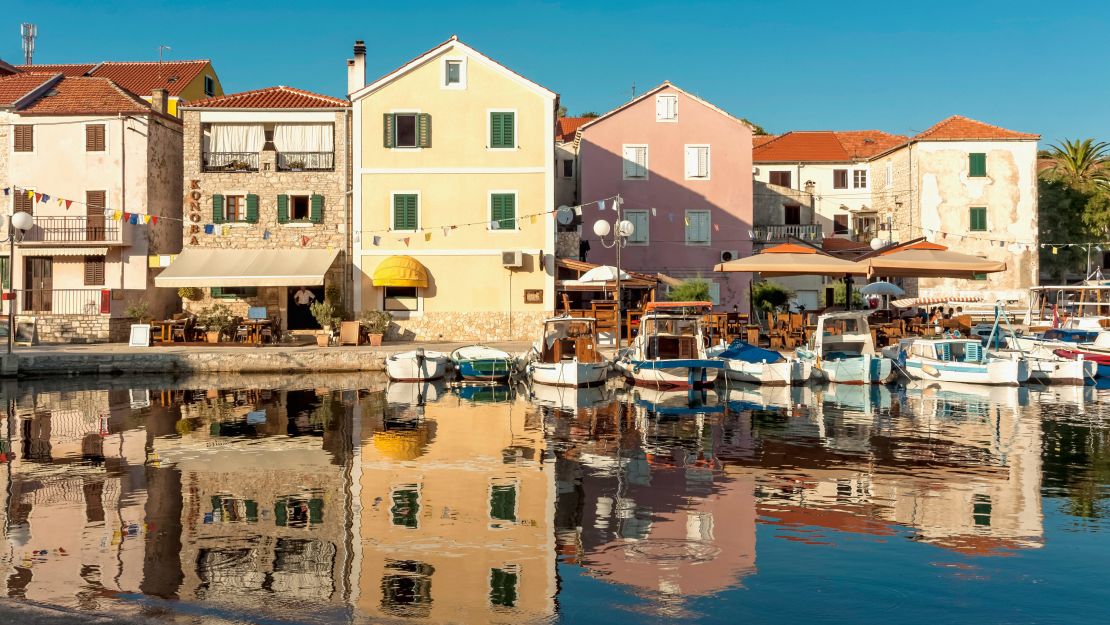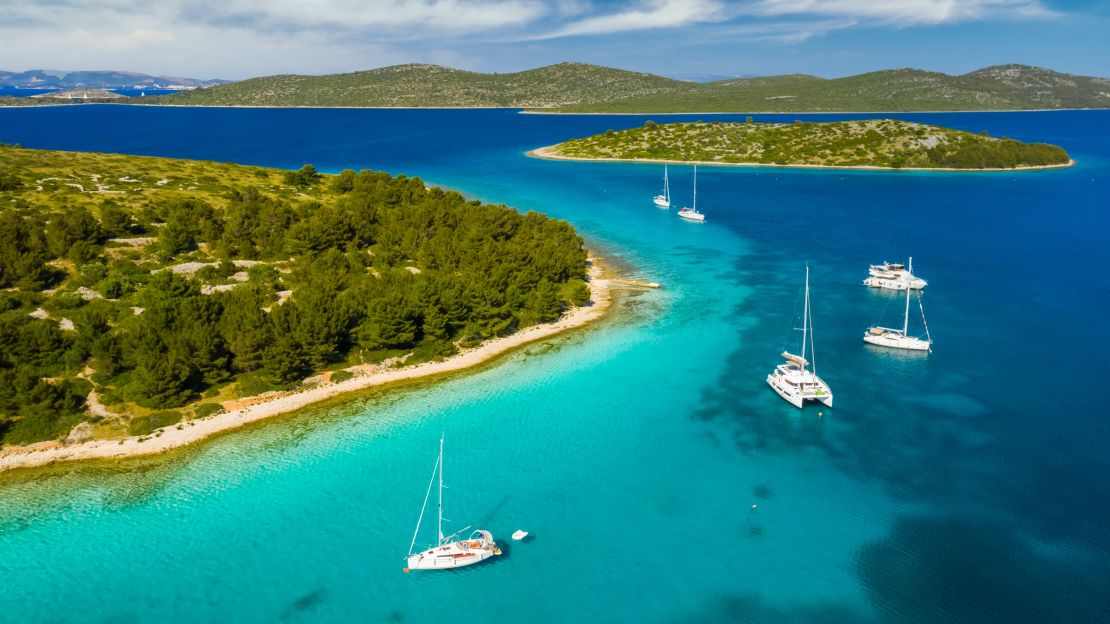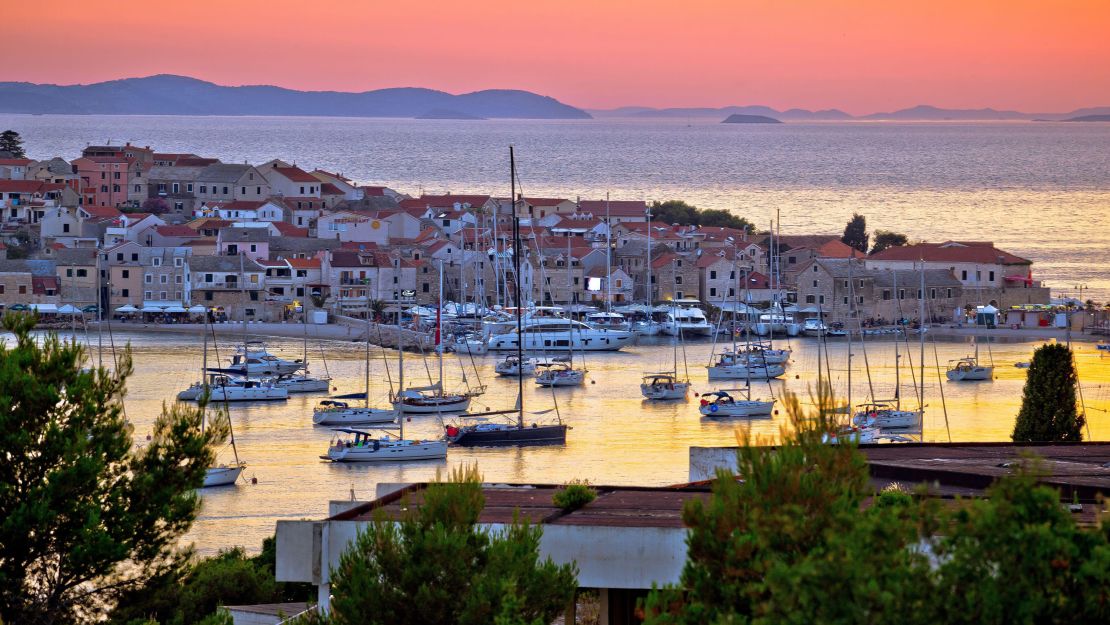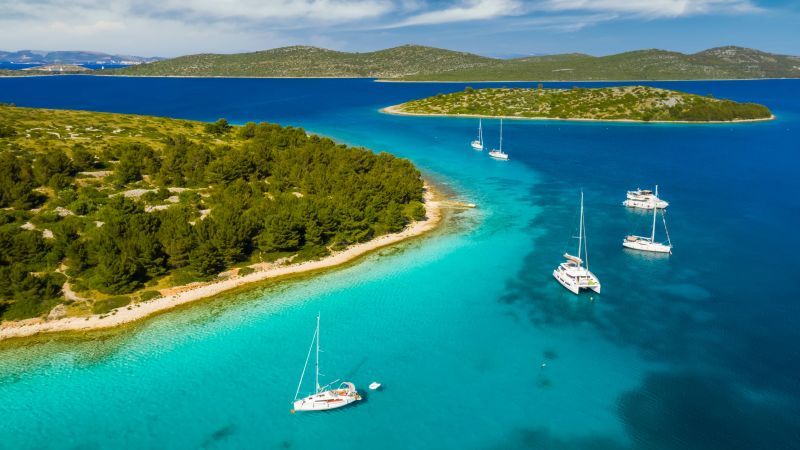Editor's note: Subscribe to Unlocking the World, CNN Travel's weekly newsletter. Get the latest news on aviation, food and drink, where to stay and other travel news.
cnn
—
If we mention Dalmatia, Split and Dubrovnik usually come to mind. But head to the northern stretch of this Croatian coastal region and you'll find a road a little less traveled.
Croatia's coast, from Zadar to Trogir, manages to pack an astonishing amount of history and culture, as well as fascinating landscapes, into less than 90 miles (about 144 kilometers).
And that's just the mainland: there are also dozens of islands scattered along the coast. Many are uninhabited; others are the kind of place you go to when you need to get away from it all.
There is even the Kornati National Park, one of the most attractive natural spaces in Croatia, spread over 89 islands. You'll soon see why traveling by boat is such an attractive option.
The large cities of Zadar and Šibenik will transport you back in time: Zadar to Roman times, Šibenik to the time of Croatia's medieval rulers. Meanwhile, Trogir, whose old town occupies its own small island, is a magical place protected by UNESCO World Heritage status. In between are attractive coastal towns, secluded beaches and an inland wine region.
Zadar and surroundings
Enter the historic center of Croatia's oldest city, founded by the ancient Liburnian tribe and colonized by the Romans in the 1st century BC. C., and you will understand what makes the country's history so fascinating. In just one square of the walled old town you will immerse yourself in centuries of history.
Trg Opatice Čike focuses on the remains of the ancient Roman forum, many of whose stones were used to build the 9th-century Church of St. Donatus next to it. Next to the church is the Romanesque Cathedral of Saint Anastasia.
Opposite, don't miss the 11th century bell tower next to the church of Santa María, a Renaissance Benedictine monastery (but with Roman and medieval elements inside). Both St. Mary's and St. Anastasia's Baptistery were destroyed during Allied bombing in 1943 and had to be rebuilt.

Stroll along Zadar's waterfront and you'll feel like you're back in the 21st century when you come across two art installations by Nikola Bašić that have become major attractions.
Sit on the gleaming marble steps by the water's edge and listen to the haunting sounds of the Sea Organ, an underwater array of tubes powered by waves. Right next door, embedded in the boardwalk, is its companion piece, “Salute to the Sun,” illuminated by blue glass panels that glow at night.
Once you've leisurely explored Zadar's excellent food market, a five-minute walk along ulica Hrvoja Vukčića Hrvatinića, it's time to hit the beach.
Follow the coast just north of the center and you'll reach the family-friendly beaches of Borik and Diklo, while just below the old town are the city beaches – Kolovare gets our vote for its lively beach bars. If you're looking for the full beach experience, head about four kilometers south of Kolovare and you'll reach the town of Bibinje, whose nearly three miles of beaches end at Croatia's largest marina.
Before leaving the mainland, make a quick detour about 16 kilometers (10 miles) north of Zadar toward the attractive small town of Nin. Its setting is unusual: two protective strips of sandy beach curve around the old town, which sits on its own small island connected by two bridges.
The surrounding salt flats give an idea of the importance of Nin during the Middle Ages, which you can see with your own eyes by visiting the Nin Salt Flats.
Take a tour of the museum and discover that little has changed in the last 1,000 years: salt is still harvested by hand. Once you've explored the narrow streets of the old town, head to the sandy Queen's Beach just outside and join the locals smearing themselves in the “therapeutic” mud you'll find among the reeds behind the beach.

The numerous islands scattered off the coast of Zadar are some of the quietest in Croatia and many of them can be reached by ferry.
The two closest and most easily accessible (Ugljan and Pašman) are just 25 minutes away by boat and are almost like suburbs of Zadar, albeit suburbs covered in olive groves, dotted with pebble coves and crisscrossed by hiking and cycling trails. .
Silba, about three hours by ferry from Zadar, is one of the most remote, a quiet place where cars and even bicycles are not allowed during the summer months. Its smaller neighbor, Olib, is on the same ferry route and seems even more remote.
Head about two hours west from Zadar by fast ferry and you'll reach the winding Dugi Otok, which translates to “long island.” Drive along its coast to find small fishing villages, former bunkers for Yugoslav military submarines, and Veli Rat, the tallest lighthouse in the Adriatic at 135 feet.
Climb to the top for views of the northern coast of Dugi Otok and neighboring islands. While you'll find that most of the island's beaches are pebble coves, there is sand at Sakarun on the west coast, while at the southern end lies the charming Telašćica Nature Park, whose 25 coves and six islets are wedged into a claw-shaped landscape. of oak forests and olive groves lined with paths.
Follow the trail to the inland saltwater lake Mir, or “peace.” When it's not high season, it lives up to its name.

Sailors have long known the joys of sailing around Kornati National Park, an archipelago of 89 eerily arid but tremendously beautiful islands just south of Dugi Otok.
If you want to go off the grid, this is the place to do it: there is no running water or electricity anywhere on the islands, only rainwater, gas and solar power. In fact, there is not even a permanent population, apart from the occasional flock of sheep.
Once the season starts, some of the islands, including Kornati, Priškera and Levrnaka, come to life. Restaurants and rental cabins open for boating fans, and there is also a well-equipped marina in Priškera.
There is little to do except swim, eat, drink, maybe do a bit of walking and repeat. If you don't have your own boat, join a boat tour from Murter, an island close to the mainland that is connected by a bridge.

Curiously, one of Croatia's largest cities is overlooked by most tourists, but Šibenik is a must-see.
Founded in the 11th century AD by Croats (not Romans or Greeks, like other Dalmatian cities), it is home to the magnificent UNESCO World Heritage Site of St. Jakov's Cathedral, a marvel of Gothic Renaissance, with a frieze of 71 sculpted portraits around the outside.
The Venetians ruled here from 1412 to 1797, and it's easy to get pleasantly lost in the maze of marble streets they left in the historic center, but save time to visit three of the city fortresses they built.
The quickest to get to, St. Michael's, is less than a 10-minute walk from the seafront and also serves as an open-air venue for pop concerts in the summer with magnificent views of the Adriatic.
Also look out for signs that will take you about five minutes south of the fortress to the fragrant medieval Mediterranean garden of the Monastery of San Lorenzo. Breathe in the aromas of lavender, rosemary and wild herbs as you relax on the garden benches.
Šibenik is often used as a starting point for visits into the Krka National Park, whose waterfalls are at least as impressive as those of the more famous Plitvice Lakes National Park.
Buses leave Šibenik for the riverside town of Skradin, 20 kilometers to the north, from where you take a boat east along the Krka River past seven stupendous waterfalls. The most famous is Skradinski Buk, with 17 waterfalls that cascade over each other.
At this point you can disembark and follow the path to get a closer look before entering the lush vegetation that flanks the river. The boat stops at several points, including the thundering Roški Slap waterfall and the monastery on Visovac Island.
Late spring, early summer and autumn are good times to visit, as water levels can drop during the summer months.

Wine lovers can base themselves in the charming town of Primošten, about 18 miles (28 kilometers) south of Šibenik. You'll be in a prime spot to visit nearby wineries specializing in the native Babić grape, which produces a smooth, fruity red wine in a landscape of hills and olive groves; try Matošin or Prgin.
The old town of Primošten is located on its own small island connected to the newer town by a causeway. Its stepped alleys lead to the 15th-century St. George's Church and beautiful views of the Adriatic. Look for a small promontory just north of the old town, where you'll see pebble beaches surrounded by pine trees.

The walled old town of tiny Trogir also sits on its own little island, sandwiched between the mainland (where the newer part of the city is located) and the sprawling island of Čiovo, whose northern and western coasts are lined with resorts. beach Bridges that connect all three.
Stand in its central square next to the Romanesque Cathedral of San Lorenzo and you will instantly understand why the old town is on the UNESCO World Heritage list.
It is a charming mix of medieval palaces and cobbled streets, with squares where restaurants and bars squeeze into small garden courtyards.
Stroll along the Riva promenade to reach the 15th-century Kamerlengo Fortress, an atmospheric venue for classical and pop music concert performances during the summer.
María Novakovich is the author of “My family and other enemies: life and travel in the interior of Croatia“












